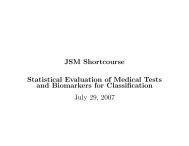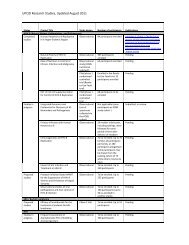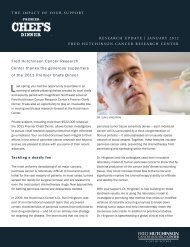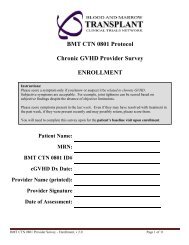Summer Undergraduate Research Program - Fred Hutchinson ...
Summer Undergraduate Research Program - Fred Hutchinson ...
Summer Undergraduate Research Program - Fred Hutchinson ...
Create successful ePaper yourself
Turn your PDF publications into a flip-book with our unique Google optimized e-Paper software.
Regula'on of Cdk2 Ac'vity by Posi've Feedback Control<br />
Madeline M. Schu. 1 , Bridget T. Hughes2 , Bruce E. Clurman2 1Whitman College, Walla Walla , WA; 2<strong>Fred</strong> <strong>Hutchinson</strong> Cancer <strong>Research</strong> Center, Sea.le, WA<br />
Gamma Irradia'on Does Not Induce<br />
Cdc25a Degrada'on<br />
Results<br />
Abstract<br />
2011 Best Poster Award<br />
Figure 6. The indicated cell<br />
lines were exposed to 10 Gy<br />
of gamma irradiaKon and<br />
harvested at the specified<br />
Kme points. Whole cell<br />
extracts were<br />
immunoblo.ed for Cdc25a,<br />
Wee1, Cdk2 and p21. Cell<br />
lysates were<br />
immunoprecipitated with<br />
Cdk2 anKbody and<br />
immunoblo.ed for<br />
phospho-‐Y15 Cdk1/2 and<br />
Cdk2.<br />
Cdk2 Inhibitory Phosphoryla'on is Reduced in<br />
Cell Lines with Increased Cdk2 Ac'vity<br />
Figure 3. The indicated cell lines were either grown asynchronously or treated with HU. Cell lysates were<br />
immunoprecipitated with Cdk2 anKbody and immunoblo.ed for phospho-‐Y15 Cdk1/2 and Cdk2.<br />
Growth Curve of Cdk2AF Cell Lines<br />
The cell cycle is a very Kghtly regulated process and the fidelity of cell division is crucial<br />
to the prevenKon of tumorigenesis and cancer growth. The key cell-‐cycle regulators are cyclin-‐<br />
dependent kinases (Cdks), protein kinases which, upon binding their regulatory molecule cyclins,<br />
become acKvated and phosphorylate target proteins o^en involved in cell cycle regulaKon. In<br />
addiKon to cyclin binding, acKvity of Cdks is also controlled by both acKvaKng and inhibitory<br />
phosphorylaKons. To be fully acKve, Cdks must be phosphorylated on T160 by Cdk acKvaKng<br />
kinase (CAK) and the inhibitory phosphorylaKons on T14 and Y15 must be removed by the Cdc25<br />
phosphatase. It is known that Cdk1 can regulate its own acKvity by inhibiKng Wee1 (the Y15<br />
kinase) and acKvaKng the Cdc25c phosphatase. This posiKve feedback control by Cdk1 is, in part,<br />
responsible for the switch-‐like mechanism of Cdk1 acKvaKon at the start of mitosis. It has been<br />
suggested that Cdk2, the G1/S-‐phase Cdk, can also feed back to regulate its own acKvity by a<br />
similar mechanism, however it has not been formally shown in vivo. To invesKgate whether Cdk2<br />
can regulate its own inhibitory phosphorylaKon in vivo, we used a geneKc approach and<br />
generated cell lines that contain a mutaKon in T14 and Y15 (Cdk2AF) that prevents inhibitory<br />
phosphorylaKon. Using immunoprecipitaKon and immunoblo_ng to assay Y15 phosphorylaKon,<br />
we show that Y15 inhibitory phosphorylaKon is reduced in Cdk2AF/+ cell lines compared to a<br />
Cdk2+/-‐ cell line (both of which have one WT Cdk2 allele). This suggests that the hyperacKve<br />
Cdk2AF can regulate Y15 phosphorylaKon on the WT copy of Cdk2. The differences in Y15<br />
phosphorylaKon between these cell lines is not due to a difference in Wee1 or Cdc25a protein<br />
levels, and shRNA-‐mediated knockdown of Wee1 failed to rescue the difference in Y15<br />
phosphorylaKon implying a Wee1-‐independent mechanism. These data support the hypothesis<br />
that Cdk2 regulates its own inhibitory phosphorylaKon by a posiKve feedback mechanism and<br />
future experiments will test if changes in Cdc25a acKvity or an unknown mechanism contributes<br />
to this posiKve feedback control. These findings provide further insight into regulaKon of Cdk2<br />
acKvity during the cell cycle and may provide addiKonal therapeuKc targets for cancers<br />
overexpressing the Cdk binding partners, cyclins A and E.<br />
Doubling Time:<br />
WT 20 Hrs<br />
+/Neo 20.5 Hrs<br />
+/AF 21.1 Hrs<br />
AF/AF 23.8 Hrs<br />
Analysis of Wee1 and Cdc25a Protein<br />
Levels in Cdk2AF Cell Lines<br />
149<br />
B<br />
A<br />
B<br />
Figure 7. These four cell lines were seeded at 88,000 cells per well in a 12-‐well plate<br />
on day zero in triplicate. Cell number was counted daily over a four day period.<br />
Cdk Inhibitory Phosphoryla'on<br />
Conclusions/Future Direc'ons<br />
C<br />
C<br />
Cdk Cdk cyclin Cdk<br />
cyclin<br />
cyclin Cdk cyclin<br />
P<br />
CAK Wee1 P<br />
P P<br />
Cdc25<br />
Ac've Inac've<br />
The data support the hypothesis that Cdk2 regulates its own inhibitory<br />
phosphorylaKon by a posiKve feedback mechanism.<br />
Figure 4. (A) The indicated cell lines were either grown asynchronously or treated with HU. Cell lysates were<br />
immunoprecipitated with Cdk1 anKbody and immunoblo.ed for phospho-‐Y15 Cdk1/2 and Cdk1. (B) The indicated cell<br />
lines were either grown asynchronously or treated with HU. Whole cell extracts were immunoblo.ed for Wee1 or (C)<br />
Cdc25a. (B) and (C) are from separate experiments.<br />
Figure 1. Cyclin-‐Cdk acKvity is regulated by both acKvaKng and inhibitory phosphorylaKons. CAK<br />
phosphorylates T160 which is required for Cdk acKvaKon. Wee1 phosphorylates T14 and Y15 which<br />
inhibits Cdk2. These phosphorylaKons must be removed by the Cdc25 phosphatase for the complex<br />
to become acKve.<br />
It is not the difference in Wee1 or Cdc25a expression across cell lines that is causing<br />
the difference in Y15 phosphorylaKon.<br />
It is possible that the observed difference in Y15 phosphorylaKon is a result of<br />
changes in Cdc25a or Wee1 acKvity, not protein levels. AlternaKvely, an unknown<br />
mechanism could be controlling this process.<br />
Methods<br />
In the future, the difference in Cdc25a and Wee1 acKvity will be measured using a<br />
Cdc25a phosphatase assay and a Wee1 kinase assay, respecKvely.<br />
Knockdown of Wee1 Does Not Rescue<br />
Differences in Y15 Phosphoryla'on<br />
AF<br />
Cdk2<br />
AF<br />
Cdk2<br />
AF<br />
Cdk2<br />
P<br />
Cdk2<br />
Cdk2<br />
P<br />
Cdk2<br />
Cdk2<br />
P<br />
Cdk2<br />
P<br />
Acknowledgements<br />
This work was funded by Grant R01 CA102742. Bridget T. Hughes is a recipient of an<br />
American Cancer Society Postdoctoral Fellowship. The <strong>Summer</strong> <strong>Undergraduate</strong><br />
<strong>Research</strong> <strong>Program</strong> is supported in parts by the Cancer Center Support Grant (CCSG)<br />
CURE Supplement: 5 P30 CA015704-‐37S1 and FHCRC AdministraKon. Special thanks<br />
to the Clurman Lab members for all their help and support!<br />
Figure 5. The indicated cell lines were infected with a virus containing a non-‐silencing control shRNA or Wee1<br />
shRNA and treated with HU. Cell lysates were immunoprecipitated with Cdk2 anKbody and immunoblo.ed<br />
for phospho-‐Y15 Cdk1/2 and Cdk2. Whole cell extracts were immunoblo.ed for Cdk2 and Wee1.<br />
WT +/Neo +/ AF AF/AF<br />
Figure 2: Diagram of cell lines used in these experiments. The cell lines +/AF and AF/AF were generated using standard<br />
AAV gene targeKng; the +/Neo cell line was an intermediate in this process.<br />
Cells were cultured in DMEM with 10% FBS and HU treatment (2mM) was done for<br />
~17hrs.<br />
ImmunoprecipitaKon and immunoblo_ng were done using standard techniques.<br />
shRNA mediated knockdown of Wee1 was performed using a lenKviral shRNA<br />
construct obtained from Open Biosystems.
















